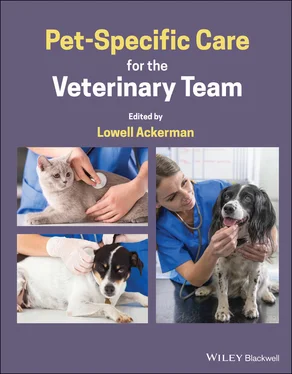There is also a secondary or indirect (knock‐on) effect for society because many of the extreme or quirky breeds are popular in advertisements and movies so demand goes up. This can increase the number of unscrupulous breeders and production farms and the number of unwanted puppies and kittens. Equally, as these dogs and cats age and owners realize they cannot afford the increased costs of healthcare, more and more animals are abandoned or relinquished, and end up in adoption centers or simply dumped on the streets.
3.5.5 What the Veterinary Team Can Do
3.5.5.1 Make Sure You All Agree!
Many practices have policies on lots of different things like drugs, procedures, hygiene and so on but subjects like ethics and welfare can get forgotten. Some members of the team may have very strong feelings on these issues but never get the chance to air them. By having frank discussions among the whole team, you can achieve a united approach. Discuss things like the ethics of fertility services for animals that are incapable of breeding naturally. Will you offer planned cesarean sections (c‐sections) or only when medically necessary? Make sure you have one or more people whose job it is to report procedures like c‐sections and conformation‐altering surgery if your purebred associations require it. Think about joining data‐sharing schemes so that an evidence base can be gathered globally.
Remember that you can help at every stage of the animal's life, and even from before conception.
Social media can be great for practices, but it is also a powerful tool in getting messages across both consciously and subliminally. If your team believes that conformational extremes are not to be encouraged, make sure that such animals are not prominently featured on any practice promotional materials or posts unless you are highlighting health issues. Do not do posts using words like “cute” in relation to extreme conformation and avoid sharing videos that people see as funny but are in fact signs of ill health, like dogs snoring and falling asleep sitting up. Always promote healthy animals and body shapes.
3.5.5.3 Prepurchase Advice
Many clients do little or no research before getting a pet (see 3.10Advising Clients on Selecting an Appropriate Pet). When it comes to breeds, the decision can be an impulse buy. This can be a problem if the breed doesn't suit the family situation but also if the owner is unaware of any potential health problems. Discuss how your practice might reach more potential clients before they get their pet. This could include client evenings, booths (stands) at fun pet shows, social media drives or articles in the local paper. Reducing demand for extremes by education is one of the best ways to influence change. Encourage clients to use contracts that empower them. Talk to clients about how to avoid production farms and third‐party sales. Make sure they know what health tests they should be expecting for the breed they have chosen (see 11.4Heritable Health Conditions – By Breed).
First visits can be difficult. The client has possibly spent hours with the breeder and may have been given spurious advice on many aspects of health and preventive medicine. It can be hard to address this in 10–15 minutes. Try and use the team effectively. Consider offering 30–60 minutes with a competent nurse as well as the veterinary visit. This way you can discuss the breed, possible health problems for the client to be aware of and look out for, as well as effective preventive healthcare and pet health insurance (see 10.16Pet Health Insurance). It's important not to blame the client for poor choices.
Try not to think of “normal for breed.” We should be open and honest about things that may be considered ‘typical” for a breed but are not normal for the species. Examples would be exophthalmos, entropion, excessive skinfolds, narrow nostrils, snoring, or respiratory noise and malformed or crowded teeth. Document all abnormalities and discuss them with the owner.
3.5.5.5 Ongoing Care and End of Life
The level of intervention needed will vary greatly depending on the animal and the severity of the problems. Specialist referral may be required but there will also undoubtedly be times that the client cannot afford the treatment necessary. It can be good to discuss within the practice and with the client possible outcomes and where you might decide it is time to offer euthanasia or signing the animal over if treatment may be possible and appropriate with a new owner or adoption center.
 TAKE‐AWAYS
TAKE‐AWAYS
Extreme conformation is unnatural and can lead to a variety of health issues and suffering, some of which can be life‐threatening.
The veterinary team should not normalize health problems just because they are common in a certain breed.
Having a united approach and understanding across the whole practice team is important for client education and consistency of messaging, especially on social media.
Try to formulate strategies for reaching prospective clients before they acquire a pet. Prepurchase education is key to reducing demand for extreme body shapes.
Be open and honest with clients about their pets but remember they are not always to blame for poor choices and may have been misinformed by breeders, peers, and the internet!
 MISCELLANEOUS
MISCELLANEOUS
Recommended Reading
1 Gough, A., Thomas, A., and O'Neill, D. (2018). Breed Predispositions to Disease in Dogs and Cats, 3e. Ames, IA: Wiley Blackwell.
Jerold S. Bell, DVM
Department of Clinical Sciences, Cummings School of Veterinary Medicine at Tufts University, North Grafton, MA, USA
 BASICS
BASICS
3.6.1 Summary
Genetic testing encompasses all evaluations that reveal hereditary predisposition to traits and disorders. These include physical genetic screening for disease as well as DNA tests of the genotype. These evaluations can assist with diagnosis, prognosis, treatment, and, in breeding animals, breeding recommendations. The veterinary team is increasingly presented with direct‐to‐consumer DNA test results for interpretation. It is up to the profession to educate itself on the types of genetic tests available, the validity of the individual tests, the applicability of each test for each breed, and what they tell you about the individual dog or cat. Genetic testing must be considered within a strategy of genetic counseling (see 3.8Genetic Counseling).
Allele:One copy of a gene in a gene pair.
Chromosome:The physical structure of DNA in pairs, one from the sire and one from the dam. The number of chromosomes varies between species.
Deoxyribonucleic acid (DNA):The chemical structure of the genetic instruction set containing coding and regulatory genes.
Gene:A length of DNA that codes for a specific protein, enzyme, or cellular event.
Читать дальше

 TAKE‐AWAYS
TAKE‐AWAYS MISCELLANEOUS
MISCELLANEOUS BASICS
BASICS










